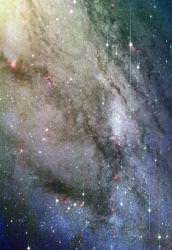When astronomers look into the night sky, almost every single galaxy is speeding away from us, carried by the expansion of the Universe. There’s one notable exception; though, the massive Andromeda galaxy (aka M31), which is speeding towards us at a rate of 120 km/s. And some time in the next few billion years, our two galaxies will collide and begin the lengthly process of merging together. Our Sun, and even the Earth should still be around, so it begs the question, what will happen to our Solar System?
Fortunately, T. J. Cox and Abraham Loeb from the Harvard-Smithsonian Center for Astrophysics have done the math in their recent paper entitled The Collision Between The Milky Way And Andromeda. In this paper, they chart out their simulation of this massive collision, and estimate some future fates for our Solar System.
Our galaxy, the Milky Way, and Andromeda (M31) together with their 40 smaller companions make up the two largest members of the Local Group of galaxies. While most galaxies are hurtling away from us as part of the expansion of the Universe, the Local Group is gravitationally bound together, and will continue to interact over the coming years.
When our Sun was born, 4.7 billion years ago, Andromeda and the Milky Way were 4.2 million light-years apart. Steadily moving together over the billions of years, they’re now only 2.6 million light-years apart and clearly headed for a collision. But it won’t be a head-on collision, the two galaxies will take swipes at each other first.
The first sideswipe will occur less than 2 billion years from now. During that first interaction, there’s a 12% chance that the Solar System might get ejected from the disk of the Milky Way, and spun out into the tidal tail of material that will stream out from the Milky Way. And there’s a remote chance, less than 3%, that the Sun will jump ship, joining up with Andromeda, and leaving the Milky Way entirely.
Since the Sun and the Earth will still be around, future astronomers could witness the collision in all its glory. Since the Sun will be steadily increasing its output of radiation, life might not be able to survive on our planet if engineers can’t figure out a way to keep the Earth moving away from the Sun.
Then the galaxies will come back together for another swipe, and then another, and eventually settle down into a gigantic swarm of stars buzzing around a common center of gravity. Currently quiet, the twin supermassive black holes may flare up, becoming active galactic nuclei, feasting on the torrent of new material that was unlucky to enter their feeding zones. Colliding clouds of gas and dust will flare up in furious regions of star formation.
In all likelihood, these interactions will push the Sun out into the new galaxy’s outer halo, pushing us at least 100,000 light years from the centre, and safely way from those twin black holes.
And 7 billion years from now, when our Sun is in the last stages of life – a red giant – and our Earth is a burned cinder, Milkomeda will have formed.
(At least, that’s what Cox and Loeb are calling it. I coined Milkdromeda in an episode of Astronomy Cast.)
This future galaxy will be a massive, elliptical galaxy, losing any remnant of its familiar spiral arms. The furious star formation will settle down, and this new galaxy will live out its remaining years, slowly using up its remaining raw stellar material.
100 billion years from now, all galaxies not bound to the Local Group will recede from vision – now traveling away from us faster than the speed of light. The concept of extragalactic astronomy will end, and Milkomeda will account for the entire visible Universe.
Original Source: Arxiv


if i had one wish in life it would be to witness this event without dieing during the process
My brain just exploded in my head.
Lol milkomeda?
I find the idea of the Sun being ejected from the Milky Way terrifying.